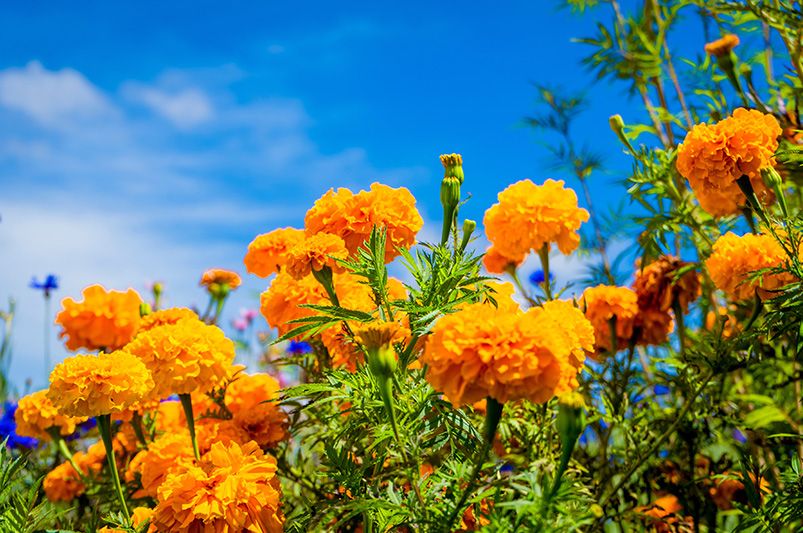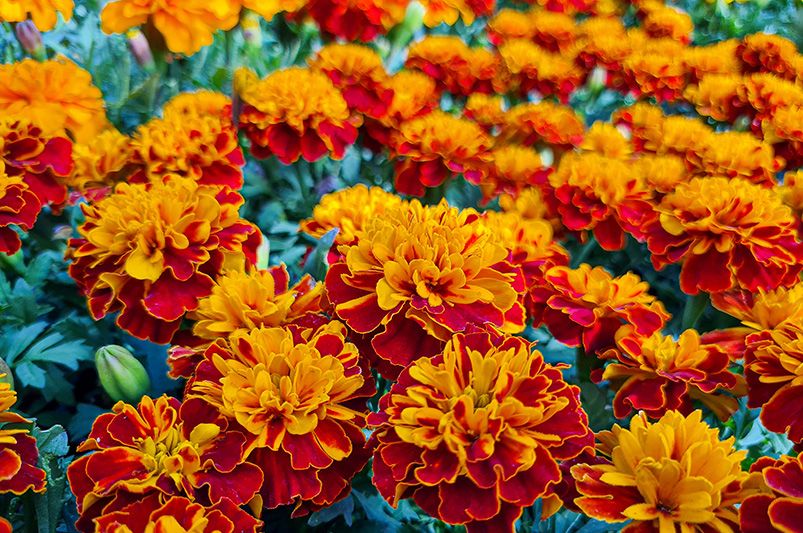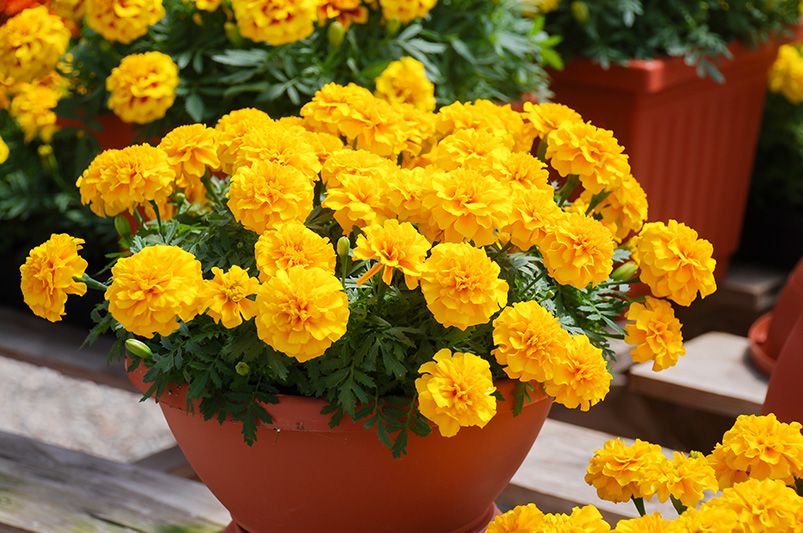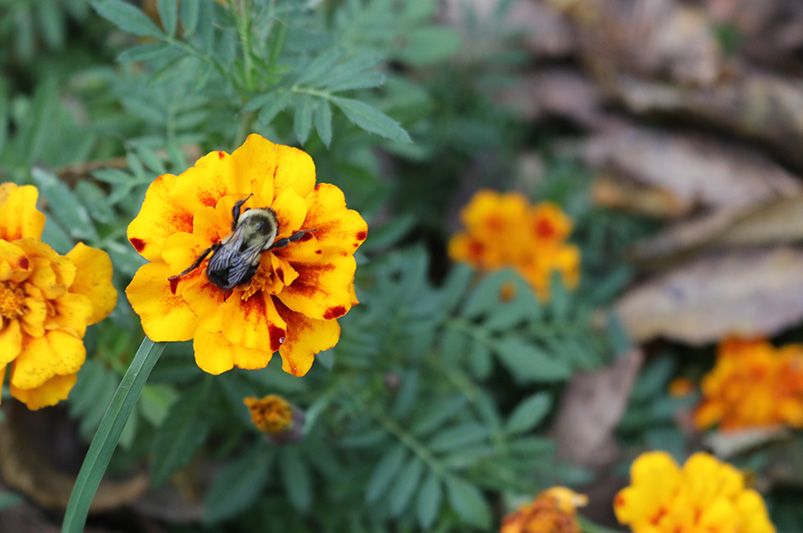
A Symphony of Sunshine: Exploring the Diverse Colors and Forms of Marigold Varieties
Published: 09/07/2024 | Updated: 09/07/2024
Marigolds, with their vibrant hues and cheerful blooms, have graced gardens and celebrations across the globe for centuries. These resilient flowers, native to the Americas, have woven themselves into the cultural tapestry of many civilizations, symbolizing everything from love and loss to creative passion and spiritual reverence.


Originally cultivated by the Aztecs and other pre-Columbian civilizations, marigolds were cherished for their medicinal properties and played a vital role in religious ceremonies. Their distinctive aroma and vivid colors made them a favored offering to the gods, adorning temples and altars. When the Spanish conquistadors arrived in the Americas, they were captivated by these radiant blooms and facilitated their spread across Europe and eventually, the world. In this article, we will talk about Marigold varieties and how it’s suitable for various garden settings.
Marigolds in Art and Culture
Marigolds have long held a significant place in various cultures worldwide, inspiring artists, writers, and craftspeople to capture their vibrant hues and symbolic meanings. In Mexican culture, marigolds play a central role in the celebrations of Día de los Muertos (Day of the Dead). The bright orange and yellow flowers are used to create intricate designs and pathways, believed to guide the souls of the departed back to their families.
In India, marigolds are an integral part of religious ceremonies and festivals, adorning deities and decorating spaces with their warm, radiant petals. The flowers are woven into garlands and used in rangoli patterns, adding a touch of vibrancy to traditional rituals and celebrations.
Marigolds have also found their way into the realm of art, inspiring painters, sculptors, and textile artists alike. Their bold colors and distinctive shapes have been captured on canvas, carved into wood, and embroidered onto fabrics, celebrating the beauty and diversity of these resilient blooms.
In literature, marigolds have been used as symbols of grief, passion, and resilience, appearing in works by renowned authors such as Pablo Neruda and Gabriel García Márquez. Their presence in these literary masterpieces adds depth and meaning, reflecting the cultural significance of these unassuming yet captivating flowers.
Whether adorning altars, decorating homes, or gracing the canvases of artists, marigolds have transcended their role as mere flowers, becoming a vibrant expression of cultural identity, artistic inspiration, and the enduring bond between humans and nature.

Marigold Varieties for Gardens
Marigolds are a gardener's delight, offering a vibrant and diverse array of varieties suitable for various garden settings. From compact dwarf varieties to towering giants, marigolds come in a spectrum of colors, shapes, and sizes to complement any outdoor space.
Alumia Vanilla Cream
Alumia Vanilla Cream, an enchanting variety of French Marigold (Tagetes patula 'Alumia Vanilla Cream'), captivates with its creamy white blooms edged in subtle shades of yellow. This delightful annual adds a soft, vintage charm to gardens and containers, providing a continuous display of color from late spring until frost. Perfect for borders, edging, or as a companion plant in vegetable gardens, Alumia Vanilla Cream is not only beautiful but beneficial, deterring common garden pests.
Plantation & Growth
Thriving in USDA zones 2-11, Alumia Vanilla Cream is adaptable and easy to grow in full sun to partial shade. It prefers well-draining soil enriched with organic matter. For an early start, sow seeds indoors 6-8 weeks before the last frost date, or directly in the garden after all danger of frost has passed. Seeds typically germinate in 7-14 days, with plants reaching up to 12 inches in height and spreading 6-8 inches. Thin seedlings to prevent overcrowding and promote robust growth.
Plant Care
Alumia Vanilla Cream marigolds are low maintenance, requiring regular watering to keep the soil evenly moist, especially in hot, dry conditions. Though drought-tolerant once established, consistent moisture will ensure the best flowering. A monthly balanced fertilizer will support continuous blooming but avoid overfeeding, which can lead to more foliage than flowers.
Pruning & Propagation
Deadheading spent flowers encourages more blooms and keeps plants tidy. While marigolds can self-sow, saving seeds from favored plants allows controlled propagation and the joy of sharing. Collect seeds from dried flower heads at the end of the season.
Common Pests & Diseases
Generally pest-resistant, Alumia Vanilla Cream marigolds can occasionally encounter issues with aphids and slugs, easily managed through natural predators or non-chemical treatments. Root rot can be a concern in poorly draining soils, emphasizing the importance of good site preparation.

Antigua Orange Hybrid Triploid Hybrids
Antigua Orange Hybrid Triploid Hybrids, a robust and vibrant variety of marigolds (Tagetes erecta), bring a burst of intense orange color to summer gardens. Known for their large, double blooms and strong stems, these hybrids are particularly valued for both their visual appeal and their ability to withstand hot summers better than many other marigold types.
Plantation & Growth
Suitable for growing in USDA zones 2-11, Antigua Orange thrives in full sun, requiring at least 6 hours of direct sunlight daily. They prefer rich, well-draining soil. Start seeds indoors about 6-8 weeks before the last frost to get a head start on the growing season, or sow directly in the garden once the danger of frost has passed. With a growth height of up to 12-16 inches and a similar spread, Antigua Orange makes an excellent choice for both garden beds and containers.
Plant Care
These marigolds need moderate watering, particularly in dry conditions, but be careful not to overwater as they dislike soggy soil. They benefit from a balanced, slow-release fertilizer applied at the time of planting and monthly thereafter. Regular watering and fertilization will promote vibrant, long-lasting blooms throughout the season.
Pruning & Propagation
Deadheading the spent blooms not only keeps your garden looking neat but also encourages more flowers to develop, extending the blooming period. While these hybrids do not typically produce viable seeds for propagation due to their triploid nature, they can be easily propagated from cuttings.
Common Pests & Diseases
Antigua Orange is largely resistant to pests but can be susceptible to common marigold problems such as spider mites and aphids, particularly in hot, dry conditions. They are also prone to powdery mildew and rust if not provided with good air circulation. Regular inspections and proper plant care can help manage these issues effectively.
Autumn Orange
Autumn Orange, a dazzling cosmos variety (Cosmos sulphureus), lives up to its name by producing brilliant orange blooms that evoke the warm tones of the fall season. This annual brings a striking display of color to any garden setting, reaching its full potential in the latter part of the growing season when many other plants start to fade.
Plantation & Growth
Cosmos Autumn Orange is well-suited to a range of climates, generally falling within USDA zones 2-11. They prefer a sunny location, as full sun encourages the most abundant blooms. These flowers are not fussy about soil types, though they do best in soil that is well-draining and not too rich – overly fertile soil can lead to lush foliage at the expense of blooms. Sow seeds directly into the garden after the last frost date, as the cosmos generally do not like to be transplanted. Seedlings emerge in 7-10 days, with plants quickly growing to a height of 1-3 feet, depending on the variety.
Plant Care
Cosmos Autumn Orange is remarkably drought-tolerant and thrives with minimal care, making it an ideal choice for gardeners seeking low-maintenance beauty. Water regularly, but allow the soil to dry out slightly between watering to promote strong root growth. An application of a general-purpose fertilizer at planting can be beneficial, but no further feeding is typically necessary.
Pruning & Propagation
Encourage bushier growth and continuous blooming by pinching off the tips of young plants and deadheading spent flowers. While cosmos are annuals and will not overwinter, they readily self-seed, providing an opportunity for natural propagation and a delightful return in the following growing season.
Common Pests & Diseases
While generally robust and trouble-free, Autumn Orange can occasionally attract aphids or suffer from fungal diseases such as powdery mildew, particularly in damp conditions with poor air circulation. Maintain spacing between plants and consider using a gentle insecticidal soap to manage pests if needed.

Crackerjack
Crackerjack, an alluring African Marigold (Tagetes erecta 'Crackerjack'), captivates gardeners with its colossal, double flowers that flourish in a medley of sunshine hues, from vibrant yellow to deep orange. This classic heirloom is cherished not only for its showstopping displays but also for its ease of growth and garden benefits.
Plantation & Growth
Crackerjack marigolds are an annual staple thriving in USDA zones 2-11. These vigorous plants prefer full sun conditions, where they receive at least 6 to 8 hours of direct sunlight daily, to part shade. They aren't picky about soil as long as it's well-drained. Start seeds indoors 6-8 weeks before the last frost date or sow directly into the ground once the threat of frost has passed. Achieving heights of up to 3 feet with a spread of 1-2 feet, Crackerjack creates an impressive backdrop for lower-growing annuals or a vibrant middle layer for mixed borders.
Plant Care
These marigolds demand little more than regular watering, ensuring the soil is damp but never soggy. They will benefit from an application of a balanced fertilizer early in the season, but additional feeding is unnecessary. Their hardiness and minimal requirements make them a favorite for novice and experienced gardeners.
Pruning & Propagation
Deadheading spent blooms prompt further flowering and keep the plant looking its best. While Crackerjack will often self-seed, gardeners can collect dry seeds from the flower heads and store them for the next season to maintain their favorite strains.
Common Pests & Diseases
Crackerjack's resistance to most pests makes it a perfect companion plant, repelling nematodes and other garden pests. They can occasionally experience issues with aphids and whiteflies, treatable with insecticidal soap. Fungal diseases like powdery mildew may develop in humid conditions, so it's important to provide adequate air circulation by spacing plants properly.
Diamond Jubilee Yellow
Diamond Jubilee Yellow marigolds (Tagetes erecta 'Diamond Jubilee Yellow') are a garden gem, offering a radiant splash of pale yellow to golden blooms that can lighten up any garden arrangement. Celebrated for their lush, double flowers and robust growth, these marigolds are a sunny addition that brings both color and substance to summer gardens.
Plantation & Growth
Thriving across USDA zones 2-11, Diamond Jubilee Yellow marigolds favor a sunny spot, achieving their best bloom in full sun, though they can tolerate partial shade. They are not particular about soil quality but require good drainage to prevent root rot. Sowing seeds directly in the garden after the last frost has passed is simple and effective. Seedlings typically emerge in 7-14 days. These marigolds reach a height of 18-24 inches with a spread of about 10-12 inches, making them an ideal choice for borders, beds, or cheerful container plants.
Plant Care
Diamond Jubilee Yellow is drought tolerant once established, yet even and regular watering during prolonged dry spells will keep them looking their best. A slow-release, balanced fertilizer at the beginning of the growing season is sufficient to support their growth. They are largely low-maintenance, requiring minimal additional care.
Pruning & Propagation
Regular deadheading of faded flowers encourages more blooms and extends the flowering period. While these marigolds typically do not propagate through cuttings, you can easily collect seeds from spent blooms to sow the following season.
Common Pests & Diseases
Resistant to many pests, Diamond Jubilee Yellow marigolds are still subject to common garden nuisances like aphids and spider mites, especially in dry, hot conditions. Proper spacing to ensure good air circulation and regular watering can help prevent powdery mildew and other fungal diseases.
No matter your garden's style or space, there's a marigold variety to suit your needs. With their vibrant colors, easy care, and versatility, marigolds are a surefire way to add a sunny touch to your outdoor oasis.
Beyond the Expected: The Enduring Allure of Marigolds
The marigold, with its vibrant hues and diverse forms, is a true symphony of sunshine. From the deep crimson and golden tones to the delicate pale yellows and creamy whites, these flowers offer a kaleidoscope of colors that can brighten any garden or bouquet. Their petal formations, too, are a delight to behold, ranging from the classic double-ruffled blooms to the whimsical single-petaled varieties.
In the end, the symphony of marigold varieties reminds us of the beauty and diversity that surrounds us, inviting us to embrace the vibrant colors and forms that nature has to offer. Whether cultivating them in our gardens or simply admiring their radiance, these sunshine-hued flowers are sure to bring warmth and joy to all who cross their path.
Transform your garden into a slice of paradise with ShrubHub! Say goodbye to bland landscapes and embrace creativity, innovation, and beauty with the click of a button. Whether you're dreaming of vibrant native shrubs, towering trees, or captivating ground covers, ShrubHub brings an unmatched selection of high-quality greenery straight to your doorstep. Visit ShrubHub now to start your journey towards a stunning garden transformation. Your dream garden awaits, and it's just a click away.


